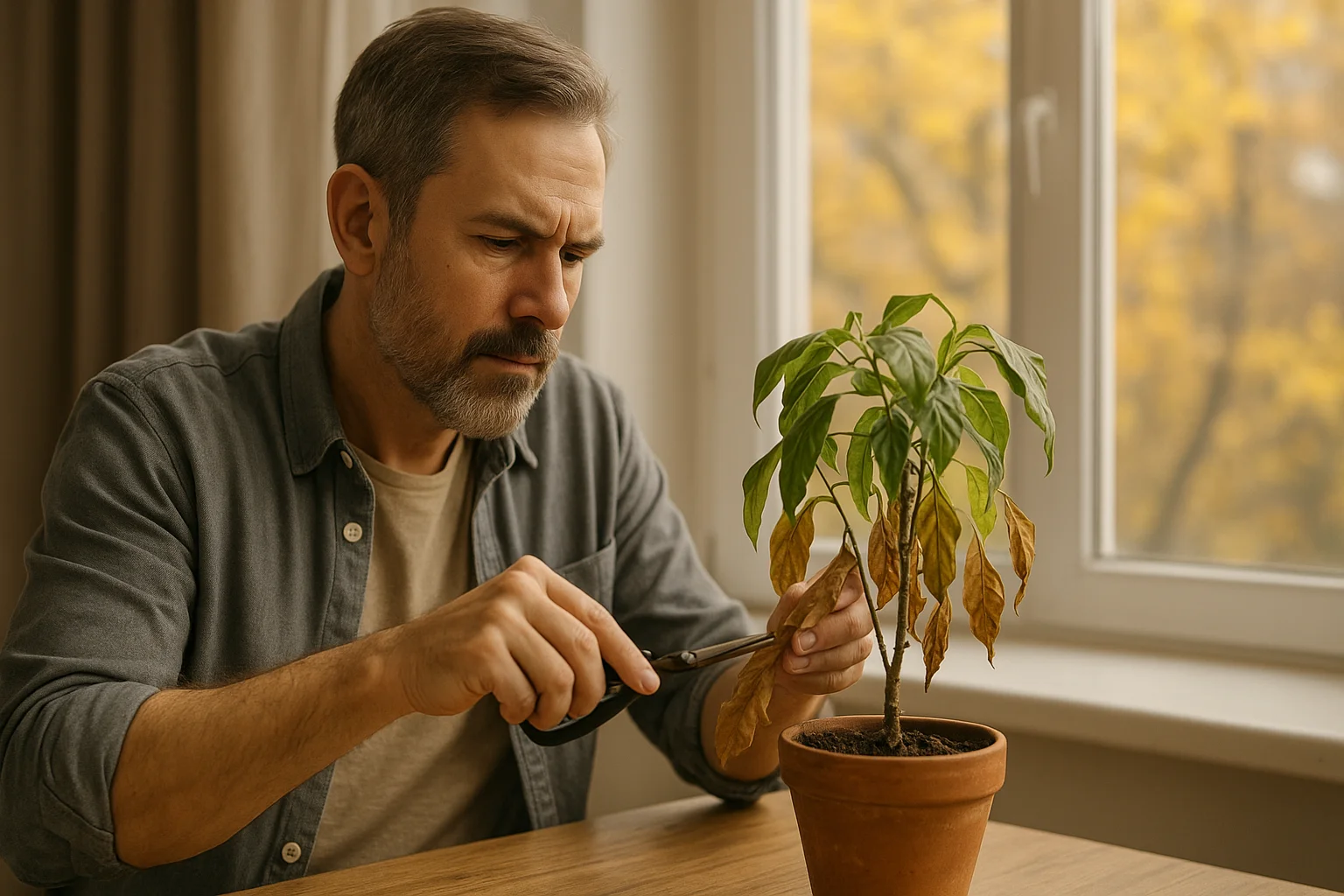Have you ever looked at a fading leaf and thought, what plant is this really, and why is it behaving so strangely this season? Many owners make the mistake of treating plants the same way all year round. Yet houseplants follow the same natural rhythm as those outdoors: brighter growth in spring and summer, slower pace in autumn, and often a rest in winter. To keep them healthy, you need to adjust light, water, and care routines with the seasons.

Seasonal Care: Why Adjustments Matter
Plants may live indoors, but they still follow the rhythm of the seasons. Longer days in summer bring rapid growth, while shorter, colder months slow everything down. Treating a plant the same way all year is one of the most common mistakes new owners make. And thanks to noticing how light, water, and rest change with the seasons, you can prevent stress before it starts. So, below you can see some recommendations.
Light Changes Through the Year
Light is the main driver of plant health, but it changes more than we notice indoors. Long summer days flood rooms with brightness, while winter brings short, dim hours. Even plants in the same corner may thrive in July and struggle in December.
The rule of thumb: protect leaves from burning in summer, and push them closer to available light in winter. Window direction also matters — south-facing windows can scorch in June, but in January they may be the only reliable source of light.
Shadow test for light strength:
Sharp, clear shadow = strong light.
Soft, blurred shadow = medium light.
Almost invisible shadow = low light.
This simple trick works all year and is often more reliable than judging by eye.
Water Needs in Summer vs. Winter
Watering mistakes are among the biggest killers of houseplants. The need for moisture depends not only on the type of plant but also on the time of year.
In summer, plants grow quickly and evaporate more water through their leaves. Soil dries faster, so frequent watering is essential. In winter, most species slow down. Their roots absorb less water, and the same routine can leave soil constantly wet — the perfect setup for rot.
Signs your watering needs adjustment:
Soil takes days to dry in winter → reduce frequency.
Leaves wrinkle or droop in hot months → increase watering.
Mold on the soil surface → water less and improve airflow.
A good habit is to test soil with your finger or a wooden skewer instead of following a fixed schedule.
The Role of Rest Periods
Winter often makes owners panic when plants stop growing or lose leaves. In most cases, this is not disease but rest. Many plants naturally slow down or “sleep” when days get short.
During rest, the plant’s metabolism shifts. Roots still function, but slowly. Forcing growth with fertilizer or extra water usually does more harm than good.
How to support resting plants:
Keep them in stable, cooler conditions.
Reduce watering to a minimum.
Stop fertilizing until spring.
Think of rest as recovery time. When spring comes, new shoots often appear stronger than before.
Fertilizer Timing Across Seasons
Fertilizer can be a friend or an enemy depending on timing. Feeding makes sense only when a plant is actively growing. Out-of-season fertilizing creates salt buildup and burns fragile roots.
Seasonal guide to fertilizing:
Season | Fertilizer Use | Key Notes |
Spring | Start light feeding every 2–4 weeks | Use diluted liquid fertilizer |
Summer | Maintain regular feeding | More growth = more demand |
Autumn | Reduce feeding gradually | Preparing for rest |
Winter | Avoid, except for winter-flowering plants | Focus on stability, not growth |
Forgetting fertilizer in winter is not neglect — it’s protection. Plants store energy better without it during their quiet months.
Humidity Fluctuations
Humidity is often invisible but vital. Indoor air changes as seasons pass. In summer, open windows and natural warmth create a comfortable environment. In winter, heating systems strip moisture from the air, dropping humidity to levels many tropical plants cannot tolerate.
Signs of low humidity include crisp brown leaf tips, curling, and fragile new growth. Some plants, such as calatheas and spathiphyllums, are especially sensitive and quickly reveal when the air is too dry.
Ways to maintain humidity:
Place plants together to create a small “humid pocket.”
Use trays with pebbles and water beneath pots.
Add a compact humidifier in very dry rooms.
By stabilizing humidity, you protect delicate leaves from unnecessary stress.
Rotation and Positioning
Plants bend toward light sources throughout the year. Left unrotated, they grow unevenly and lose their balanced shape. Seasonal drafts also create risks: cold air from a window in January or hot, dry air from vents in July can damage plants silently.
Practical rules to follow:
Rotate pots a quarter turn weekly.
In winter, check for cold spots near doors and windows.
In summer, avoid placing plants directly against glass panes where heat builds up.
A small change in position often prevents long-term problems like weak stems or scorched leaves.
Seasonal Pests and Problems
Each season brings different threats. Summer is the high point for pests like spider mites and aphids. Warmth and open windows let them spread quickly. Winter, on the other hand, creates fungal risks, as cooler air and damp soil promote mold and rot.
Key things to check regularly:
Undersides of leaves for webbing or tiny insects.
Soil surface for fungus or algae.
Sticky residue on leaves, a sign of sap-sucking pests.
Regular inspection — even a few minutes once a week — often prevents infestations before they grow into a problem.

How Apps Can Help Adjust Care
Well, you know that observation is essential, but modern tools simplify the process. But the right apps can confirm plant identity, highlight issues, and guide seasonal care.
Among them, AI Plant Finder offers one of the most complete solutions. With a single photo, it identifies plants with around 97% accuracy and detects diseases at about 98% accuracy. And the app's database covers over 300,000 species, which makes it useful even for rare or unusual houseplants.
Additional features include:
Light Meter to check brightness where a plant sits.
Water Calculator to adjust watering based on pot size, soil type, and humidity.
My Garden Tool that creates reminders for watering, pruning, or fertilizing.
Most functions are easy to use and reduce guesswork. While some advanced features are premium, the core tools provide plenty of help for everyday care.
Creating a Yearly Plant Calendar
One of the easiest ways to keep plants thriving is to follow a yearly calendar of care. Instead of guessing each week, you’ll have a clear picture of what changes to expect and when.
A simple notebook, a wall calendar, or even a folder of monthly photos on your phone can become a powerful tool. Recording small details like the first new leaf, signs of pests, or the day you adjusted watering gives you a personal plant diary.
Here is an example of how a seasonal cycle might look:
Season | Key Care Actions | What to Watch For |
Spring | Increase watering, begin fertilizing, rotate plants more often | First new shoots, faster soil drying |
Summer | Monitor pests, adjust light, maintain humidity | Sunburn spots, spider mites, crisp leaf tips |
Autumn | Reduce watering, cut back on fertilizer, prepare for rest | Slower growth, natural leaf drop |
Winter | Keep conditions stable, avoid sudden moves, let plants rest | Dormancy, soil staying damp longer |
It can be also wise to keep notes alongside these seasonal phases, as this way you start to recognize patterns unique to your home. For example, you may see that one plant attracts pests every July, or another tends to drop leaves in October.
With this knowledge, you can anticipate problems and adjust care before they become serious. Over time, your personal calendar turns into a custom guide perfectly matched to your plants and living space.
Let Plants Follow Their Rhythm
Seasonal plant care is not about strict rules; it’s about observation and timing. Light changes with the sun’s path, water needs rise and fall with growth, and rest is a natural pause, not a sign of failure, and thanks to respecting these shifts, you give plants the balance they need.
If you are not sure what to do, you can refer to tools like AI Plant Finder to add confidence by identifying species, guiding adjustments, and warning of risks. But the heart of care is simple: look closely, respond to what you see, and let your plants follow their rhythm. Healthy growth will be your reward in every season.
